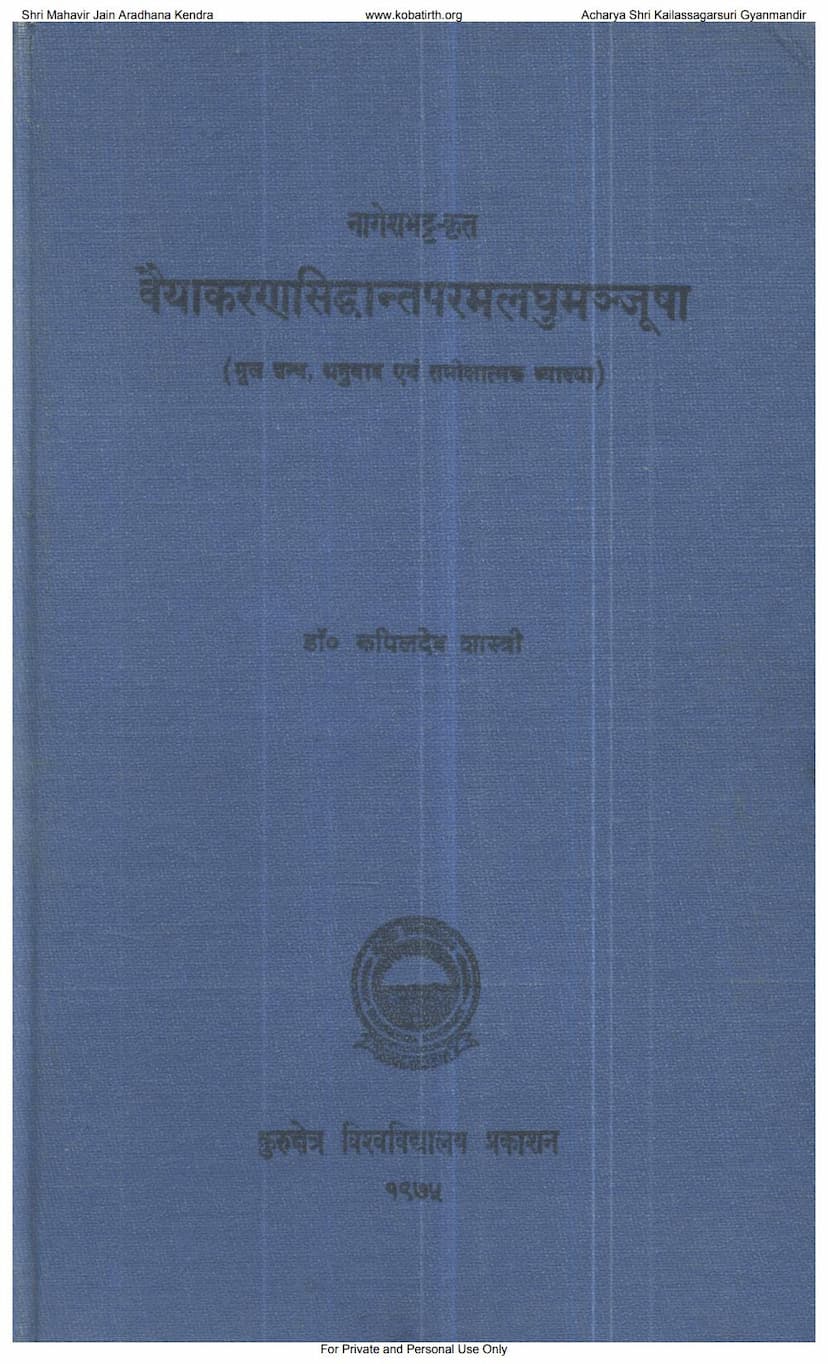Vyakaran Siddhant Param Laghu Manjusha
Added to library: September 2, 2025

Summary
Based on the provided text, here's a comprehensive summary of the Jain text "Vyakaran Siddhant Param Laghu Manjusha":
Book Title: Vyakaran Siddhant Param Laghu Manjusha Author(s): Nagesh Bhatt (original text), Kapildev Shastri (Editor and Commentator) Publisher: Kurukshetra Vishvavidyalay Prakashan Year: 1975 Subject: Sanskrit Grammar and Philosophy of Language (Vyakarana Darshan)
Core Content and Purpose:
The book is a critically edited Hindi translation and commentary of Nagesh Bhatt's "Vyakaran Siddhant Param Laghu Manjusha." This text is a concise yet profound exploration of the philosophical underpinnings of Sanskrit grammar, known as Vyakarana Darshan or Shabda Darshan. The primary aim of the work is to present Nagesh Bhatt's synthesis of ancient Indian linguistic philosophy, particularly the influential theories of Bhartrihari, and to analyze Nagesh's own contributions to this field.
Key Themes and Philosophical Standpoints:
- The Ultimate Reality of Sound (Shabda Brahma): The text, like much of Indian philosophy of language, posits that the ultimate reality is Sound (Shabda), which is equated with Brahman. This primordial Sound, in its subtle form (Para Vak), is the source of all manifestation and knowledge.
- The Concept of Sphota: A central concept in this grammatical philosophy is "Sphota," which refers to the indivisible, eternal, and meaningful unit of sound or word that conveys meaning, as opposed to the fleeting sounds (Dhvani) that merely manifest it. The text delves into the different classifications of Sphota (वर्णस्फोट, पदस्फोट, वाक्यस्फोट) and their philosophical implications.
- The Nature of Language and Meaning: The book meticulously analyzes the relationship between words (Shabda), their meanings (Artha), and the connection (Samyoga/Sambandha) between them. It discusses various theories of meaning (Shakti, Lakshana, Vyanga) and their philosophical bases.
- Critique of Other Philosophical Schools: A significant portion of the text involves Nagesh Bhatt's critical engagement with the theories of other Indian philosophical schools, particularly Nyaya and Mimamsa, regarding linguistic concepts like the nature of meaning, the source of linguistic convention, and the validity of linguistic analysis.
- Nagesh Bhatt's Contribution: Nagesh Bhatt is presented as a pivotal figure who revived and elaborated upon Bhartrihari's philosophy of language. His work is noted for its depth, scholarly rigor, and integration of Navya-Nyaya methodologies into grammatical analysis, making his writings often complex but highly rewarding for serious scholars.
- Structure of the Text: The book is structured with an extensive introduction (Bhumika), the main text of the "Param Laghu Manjusha," followed by detailed chapters covering key concepts such as:
- Shakti Nirupan (Theory of Meaning/Power)
- Lakshana Nirupan (Theory of Implied Meaning/Metaphor)
- Vyanjana Nirupan (Theory of Suggestion/Indication)
- Sphota Nirupan (Theory of the Indivisible Unit of Sound/Meaning)
- Akanksha-Yogyata-Asatti-Tātparya Vichar (Analysis of Syntactic Expectancy, Congruity, Contiguity, and Intention)
- Dhatvartha Nirnay (Determination of Verb Roots' Meanings)
- Nipatartha Nirnay (Determination of Indeclinables' Meanings)
- Dasha-Lakaradeshartha Nirnay (Determination of Meanings of Ten Tenses/Moods' Substitutions)
- Lakarartha Nirnay (Determination of Tense/Mood Meanings)
- Karaka Nirupan (Analysis of Grammatical Cases/Agents)
- Namartha (Meaning of Nouns/Nominals)
- Samasaadi Vrityartha (Meanings in Compounds and Other Syntactic Operations)
Editor's Contribution (Kapildev Shastri):
Dr. Kapildev Shastri's work is highlighted as an exemplary critical edition. It includes:
- Thorough Editing: Based on various manuscripts and published editions to establish a pure text.
- Hindi Translation: A clear and accessible translation of the original Sanskrit text.
- Critical Commentary: Detailed explanations and analyses of Nagesh Bhatt's often dense philosophical arguments, often tracing the roots of these ideas to earlier Sanskrit grammarians and philosophers like Panini, Katyayana, Patanjali, and Bhartrihari.
- Comparative Study: The introduction includes a comparative analysis of Kaundabhatta and Nagesh Bhatt, shedding light on influences and divergences in their grammatical thought.
Significance and Value:
- Revival of Classical Thought: The publication makes a seminal work of Sanskrit grammatical philosophy accessible to a wider audience through Hindi.
- Scholarly Resource: It is considered invaluable for scholars and students of Sanskrit grammar and Indian philosophy of language, providing a deep dive into concepts like Shabda Brahma, Sphota, and the metaphysical aspects of language.
- Comprehensive Analysis: Dr. Shastri's commentary is praised for its depth, clarity, and ability to unravel the intricacies of Nagesh Bhatt's complex exposition, making the material accessible to those interested in advanced study.
In essence, "Vyakaran Siddhant Param Laghu Manjusha," as presented by Kapildev Shastri, is a significant academic endeavor that illuminates the sophisticated philosophical system underlying Sanskrit grammar, highlighting the enduring legacy of Nagesh Bhatt and the rich tradition of Indian linguistic thought.